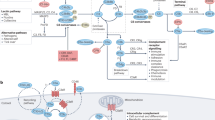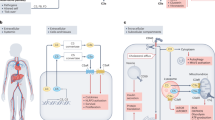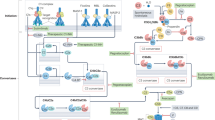Abstract
The serum complement system, which represents a chief component of innate immunity, not only participates in inflammation but also acts to enhance the adaptive immune response. Specific activation of complement via innate recognition proteins or secreted antibody releases cleavage products that interact with a wide range of cell surface receptors found on myeloid, lymphoid and stromal cells. This intricate interaction among complement activation products and cell surface receptors provides a basis for the regulation of both B and T cell responses. This review highlights fundamental events, explaining how complement links innate and adaptive immunity as well as describing more recent studies on how this large family of proteins functions locally in peripheral lymph nodes to enhance B and T cell responses.
This is a preview of subscription content, access via your institution
Access options
Subscribe to this journal
Receive 12 print issues and online access
$209.00 per year
only $17.42 per issue
Buy this article
- Purchase on SpringerLink
- Instant access to full article PDF
Prices may be subject to local taxes which are calculated during checkout


Similar content being viewed by others
References
Bordet, J. & Gengou, O. Sur l'existence de substances sensibilisatrices dans la plupart des serum antimicrobiens. Ann. Inst. Pasteur 15, 289–302 (1901).
Hosea, S.W., Brown, E.J. & Frank, M.M. The critical role of complement in experimental pneumococcal sepsis. J. Infect. Dis. 142, 903–909 (1980).
Reid, K.B.M. & Porter, R.R. The proteolytic activation systems of complement. Annu. Rev. Biochem. 50, 433–464 (1981).
Fearon, D.T. & Carroll, M.C. Regulation of B lymphocyte responses to foreign and self-antigens by the CD19/CD21 complex. Annu. Rev. Immunol. 18, 393–422 (2000).
Barton, G.M. & Medzhitov, R. Toll-like receptors and their ligands. Curr. Top. Microbiol. Immunol. 270, 81–92 (2002).
Janeway, C.A. Jr. & Medzhitov, R. Lipoproteins take their toll on the host. Curr. Biol. 9, 879–882 (1999).
Epstein, J., Eichbaum, Q.E., Sheriff, S. & Ezekowitz, R.A.B. The collectins in innate immunity. Curr. Opin. Immunol. 8, 29–35 (1996).
Matsushita, M. & Fujita, T. The role of ficolins in innate immunity. Immunobiol. 205, 490–497 (2002).
Szalai, A.J., Agrawal, A., Greenhough, T.J. & Volanakis, J.E. C-reactive protein: structural biology, gene expression, and host defense. Immunol. Res. 16, 127–136 (1997).
Korb, L.C. & Ahearn, J.M. C1q binds directly and specifically to surface blebs of apoptotic keratinocytes. J. Immunol. 158, 4525–4528 (1997).
Taylor, P.R. et al. A hierarchical role for classical pathway complement proteins in the clearance of apoptotic cells in vivo. J. Exp. Med. 192, 359–366 (2000).
Boes, M., Prodeus, A., Schmidt, T., Carroll, M.C. & Chen, J. A critical role of natural IgM in immediate response against systemic bacterial infection. J. Exp. Med. 188, 2381–2386 (1998).
Baumgarth, N. et al. B1 and B2 cell-derived immunoglobulin M antibodies are non-redundant components of the protective response to influenza virus infection. J. Exp. Med. 192, 271–280 (2000).
Reid, R.R. et al. Endotoxin shock in antibody-deficient mice: unraveling the role of natural antibody and complement in the clearance of lipopolysaccharide. J. Immunol. 159, 970–975 (1997).
Reid, K. & Turner, M. Mammalian lectins in activation and clearance mechanisms involving the complement system. Semin. Immunopathol. 15, 307–326 (1994).
Fujita, T., Matsushita, M. & Endo, Y. The lectin-complement pathway—its role in innate immunity and evolution. Immunol. Rev. 198, 185–202 (2004).
Stahl, P.D. & Ezekowitz, R.A. The mannose receptor is a pattern recognition receptor involved in host defense. Curr. Opin. Immunol. 10, 50–55 (1998).
Fearon, D.T. & Austen, K.F. Initiation of C3 cleavage in the alternative complement pathway. J. Immunol. 115, 1357–1361 (1975).
Daha, M.R., Fearon, D.T. & Austen, K.F. C3 requirements for formation of alternative pathway C5 convertase. J. Immunol. 117, 630–634 (1976).
Liszewski, M.K., Post, T.W. & Atkinson, J.P. Membrane cofactor protein (MCP or CD46): newest member of the regulators of complement activation gene cluster. Annu. Rev. Immunol. 9, 431–455 (1991).
Fearon, D.T. & Carter, R.H. The CD19/CR2/TAPA-1 Complex of B lymphocytes: linking natural to acquired immunity. Annu. Rev. Immunol. 13, 127–149 (1995).
Fearon, D.T. & Locksley, R.M. The instructive role of innate immunity in the acquired immune response. Science 272, 50–54 (1996).
Nussenzweig, V., Bianco, C., Dukor, P. & Eden, A. Receptors for C3 on B lymphocytes: possible role in the immune response. Progress in Immunology Vol. 59 (Amos, B. ed.) 73–81 (Academic, New York, 1971).
Papamichail, M. et al. Complement dependence of localization of aggregated IgG in germinal centers. Scand. J. Immunol. 4, 343–347 (1975).
Pepys, M.B. Role of complement in the induction of immunological responses. Transpl. Rev. 32, 93–120 (1976).
Law, S.K., Lichtenberg, N.A. & Levine, R.P. Covalent binding and hemolytic activity of complement proteins. Proc. Natl. Acad. Sci. USA 77, 7194–7198 (1980).
Tack, B.F. et al. Evidence for presence of an internal thiolester bond in third component of human complement. Proc. Natl. Acad. Sci. USA 77, 5764–5768 (1980).
Isenman, D.E. The role of the thioester bond in C3 and C4 in the determination of the conformational and functional states of the molecule. Ann. NY Acad. Sci. 421, 277–290 (1983).
Lachmann, P.J. & Hughes-Jones, N.C. Initiation of complement activation. Spring. Semin. Immunopathol. 7, 143–162 (1984).
Molina, H., Kinoshita, T., Webster, C.B. & Holers, V.M. Analysis of C3b/C3d binding sites and factor I cofactor regions within mouse complement receptors 1 and 2. J. Immunol. 153, 789–795 (1994).
Kurtz, C.B., O'Toole, E., Christensen, S.M. & Weis, J.H. The murine complement receptor gene family. IV. Alternative splicing of Cr2 gene transcripts predicts two distinct gene products that share homologous domains with both human CR2 and CR1. J. Immunol. 144, 3581–3591 (1990).
Molina, H. et al. A molecular and immunochemical characterization of mouse CR2. J. Immunol. 145, 2974–2983 (1990).
Matsumoto, A.K. et al. Intersection of the complement and immune systems: a signal transduction complex of the B lymphocyte containing complement receptor type 2 and CD19. J. Exp. Med. 173, 55–64 (1991).
Carter, R.H. & Fearon, D.T. CD19:Lowering the threshold for antigen receptor stimulation of B lymphocytes. Science 256, 105–107 (1992).
Fang, Y., Xu, C., Fu, Y., Holers, V.M. & Molina, H. Expression of complement receptors 1 and 2 on follicular dendritic cells is necessary for the generation of a strong antigen-specific IgG response. J. Immunol. 160, 5273–5279 (1998).
Cyster, J.G. et al. Follicular stromal cells and lymphocyte homing to follicles. Immunol Rev. 176, 181–193 (2000).
Liu, Y.J., Grouard, G., de Bouteiller, O. & Banchereau, J. Follicular dendritic cells and germinal centers. Int. Rev. Cytol. 166, 139–179 (1996).
Barrington, R.A., Pozdnyakova, O., Zafari, M.R., Benjamin, C.D. & Carroll, M.C. B lymphocyte memory: role of stromal cell complement and FcγRIIB receptors. J. Exp. Med. 196, 1189–1199 (2002).
Cutler, A. et al. (1998) T cell-dependent immune response in C1q-deficient mice: defective interferon γ production by antigen-specific T cells. J. Exp. Med. 187, 1789–1797 (2002).
Fischer, M. et al. Regulation of the B cell response to T-dependent antigens by classical pathway complement. J. Immunol. 157, 549–556 (1996).
Ahearn, J. et al. Disruption of the Cr2 locus results in a reduction in B-1a cells and in an impaired B cell response to T-dependent antigen. Immunity 4, 251–262 (1996).
Molina, H. et al. Markedly impaired humoral immune response in mice deficient in complement receptors 1 and 2. Proc. Natl. Acad. Sci. USA 93, 3357–3361 (1996).
Carroll, M.C. The complement system in B cell regulation. Mol. Immunol. 41, 141–146 (2004).
Carsetti, R., Kohler, G. & Lamers, M.C. Transitional B cells are the target of negative selection in the B cell compartment. J. Exp. Med. 181, 2129–2140 (1995).
Norvell, A., Mandik, L. & Monroe, J.G. Engagement of the antigen receptor on immature murine B lymphocytes results in death by apoptosis. J. Immunol. 154, 4404–4413 (1995).
Karlsson, M.C. et al. Macrophages control the retention and trafficking of B lymphocytes in the splenic marginal zone. J. Exp. Med. 198, 333–340 (2003).
Pozdnyakova, O., Guttormsen, H.K., Lalani, F.N., Carroll, M.C. & Kasper, D.L. Impaired antibody response to group B streptococcal type III capsular polysaccharide in C3- and complement receptor 2-deficient mice. J. Immunol. 170, 84–90 (2003).
Hardy, R.R. & Hayakawa, K. B cell development pathways. Annu. Rev. Immunol. 19, 595–621 (2001).
Arnold, L., Pennell, C., McCray, S. & Clarke, S. Development of B-1 cells: segregation of phosphatidyl choline specific B cells to the B-1 population occurs after immunoglobulin gene expression. J. Exp. Med. 179, 1585–1595 (1994).
Herzenberg, L.A. & Kantor, A.B. B cell lineages exist in the mouse. Immunol. Today 14, 79–83 (1993).
Fleming, S.D. et al. Mice deficient in complement receptors 1 and 2 lack a tissue injury-inducing subset of the natural antibody repertoire. J. Immunol. 169, 2126–2133 (2002).
Reid, R.R. et al. Functional activity of natural antibody is altered in Cr2-deficient mice. J. Immunol. 169, 5433–5440 (2002).
Janeway, C.A. Approaching the asymtote? Evolution and revolution in immunology. Cold Spring Harb. Symp. Quant. Biol. 54, 1–13 (1989).
Pasare, C. & Medzhitov, R. Toll-like receptors: balancing host resistance with immune tolerance. Curr. Opin. Immunol. 15, 677–682 (2003).
Fischer, M.B., Ma, M., Hsu, N. & Carroll, M.C. Local synthesis of C3 within the splenic lymphoid compartment can reconstitute the impaired immune response in C3-deficient mice. J. Immunol. 160, 2619–1625 (1998).
DaCosta, X. et al. Humoral response to herpes simplex virus is complement dependent. Proc. Natl. Acad. Sci. USA 96, 12708–12712 (1999).
Ochsenbien, A. et al. Protective T cell-independent antiviral antibody responses are dependent on complement. J. Exp. Med. 190, 1165–1174 (1999).
Gustavsson, S., Kinoshita, T. & Heyman, B. Antibodies to murine complement receptor 1 and 2 can inhibit the antibody response in vivo without inhibiting T helper cell induction. J. Immunol. 154, 6524–6528 (1995).
Kopf, M., Abel, B., Gallimore, A., Carroll, M. & Bachmann, M.F. Complement component C3 promotes T-cell priming and lung migration to control acute influenza virus infection. Nat. Med. 8, 373–378 (2002).
Gerard, N.P. & Gerard, C. The chemotactic receptor for human C5a anaphylatoxin. Nature 349, 614–617 (1991).
Ames, R.S. et al. Molecular cloning and characterization of the human anaphylatoxin C3a receptor. J. Biol. Chem. 271, 20231–20234 (1996).
Kildsgaard, J. et al. Cutting edge: targeted disruption of the C3a receptor gene demonstrates a novel protective anti-inflammatory role for C3a in endotoxin-shock. J. Immunol. 165, 5406–5409 (2000).
Baumgarth, N., Herman, O.C., Jager, G.C., Brown, L. & Herzenberg, L.A. Innate and acquired humoral immunities to influenza virus are mediated by distinct arms of the immune system. Proc. Natl. Acad. Sci. USA 96, 2250–2255 (1999).
Stager, S. et al. Natural antibodies and complement are endogenous adjuvants for vaccine-induced CD8+ T-cell responses. Nat. Med. 9, 1287–1292 (2003).
Campos, R.A. et al. Cutaneous immunization rapidly activates liver invariant Va14 NKT cells stimulating B-1 B cells to initiate T cell recruitment for elicitation of contact sensitivity. J. Exp. Med. 198, 1785–1796 (2003).
Tsuji, R.F. et al. B cell-dependent T cell responses: IgM antibodies are required to elicit contact sensitivity. J. Exp. Med. 196, 1277–1290 (2002).
Drouin, S.M., Corry, D.B., Kildsgaard, J. & Wetsel, R.A. Cutting edge: the absence of C3 demonstrates a role for complement in Th2 effector functions in a murine model of pulmonary allergy. J. Immunol. 167, 4141–4145 (2001).
Drouin, S.M., Corry, D.B., Hollman, T.J., Kildsgaard, J. & Wetsel, R.A. Absence of the complement anaphylatoxin C3a receptor suppresses Th2 effector functions in a murine model of pulmonary allergy. J. Immunol. 169, 5926–5933 (2002).
Hopken, U.E., Lu, B., Gerard, N.P. & Gerard, C. The C5a chemoattractant receptor mediates mucosal defence to infection. Nature 383, 86–89 (1996).
Karp, C.L. et al. Identification of complement factor 5 as a susceptibility locus for experimental allergic asthma. Nat. Immunol. 1, 221–226 (2000).
Wittmann, M. et al. C5a suppresses the production of IL-12 by IFN-gamma-primed and lipopolysaccharide-challenged human monocytes. J. Immunol. 162, 6763–6769 (1999).
Karp, C.L. et al. Mechanism of suppression of cell-mediated immunity by measles virus. Science. 273, 228–231 (1996).
Kemper, C. et al. Activation of human CD4+ cells with CD3 and CD46 induces a T-regulatory cell 1 phenotype. Nature 421, 388–392 (2003).
Colten, H.R. & Dowton, S.B. Regulation of complement gene expression. Biochem. Soc. Symp. 51, 37–46 (1986).
Petry, F., Botto, M., Holtappels, R., Walport, M.J. & Loos, M. Reconstitution of the complement function in C1q-deficient (C1qa-/) mice with wild-type bone marrow cells. J. Immunol. 167, 4033–4037 (2001).
Schwaeble, W. et al. Follicular dendritic cells, interdigitating cells, and cells of the monocyte-macrophage lineage are the C1q-producing sources in the spleen. Identification of specific cell types by in situ hybridization and immunohistochemical analysis. J. Immunol. 155, 4971–4978 (1995).
Gadjeva, M. et al. Macrophage-derived complement component C4 can restore humoral immunity in C4-deficient mice. J. Immunol. 169, 5489–5495 (2002).
Verschoor, A., Brockman, M.A., Knipe, D.M. & Carroll, M.C. Cutting edge: myeloid complement C3 enhances the humoral response to peripheral viral infection. J. Immunol. 167, 2446–2451 (2001).
Verschoor, A., Brockman, M.A., Gadjeva, M., Knipe, D.M. & Carroll, M.C. Myeloid C3 determines induction of humoral responses to peripheral herpes simplex virus infection. J. Immunol. 171, 5363–5371 (2003).
Guinamard, R., Okigaki, M., Schlessinger, J. & Ravetch, J.V. Absence of marginal zone B cells in Pyk-2-deficient mice defines their role in the humoral response. Nat. Immunol. 1, 31–36 (2000).
Acknowledgements
I thank R. Barrington for review of the manuscript, and current and past members of the laboratory for their contributions to the understanding of how complement influences adaptive immunity. The related work from my laboratory is supported by grants from the National Institutes of Health (AI39246-09, AI36389-08, AI52343-03 and AI53570-02).
Author information
Authors and Affiliations
Corresponding author
Ethics declarations
Competing interests
The author declares no competing financial interests.
Rights and permissions
About this article
Cite this article
Carroll, M. The complement system in regulation of adaptive immunity. Nat Immunol 5, 981–986 (2004). https://doi.org/10.1038/ni1113
Published:
Issue Date:
DOI: https://doi.org/10.1038/ni1113



